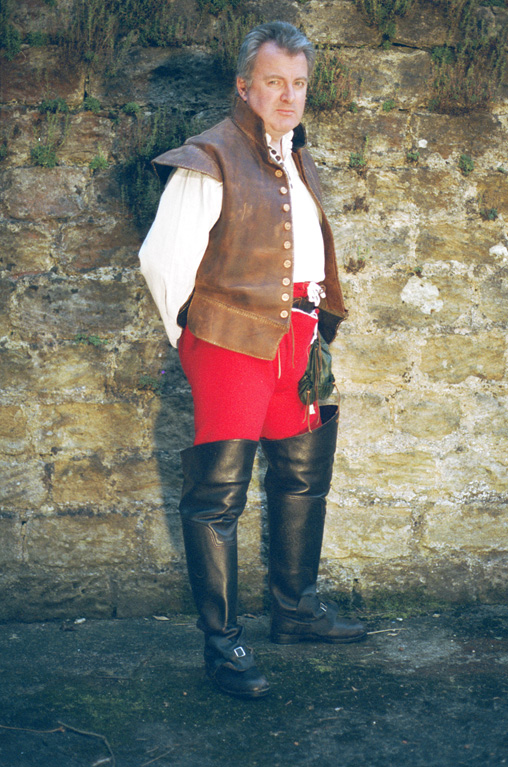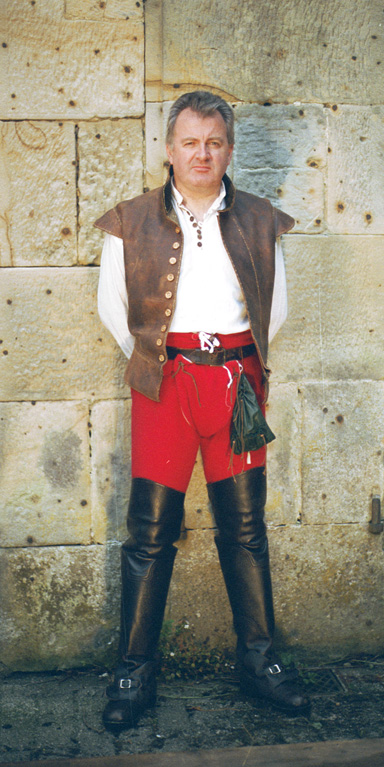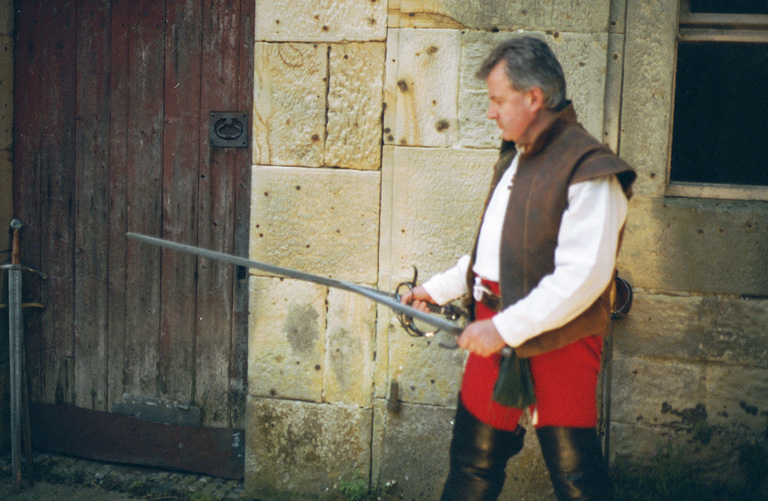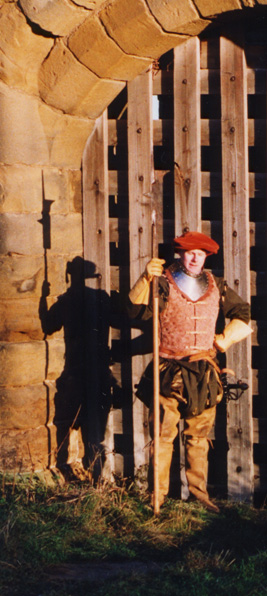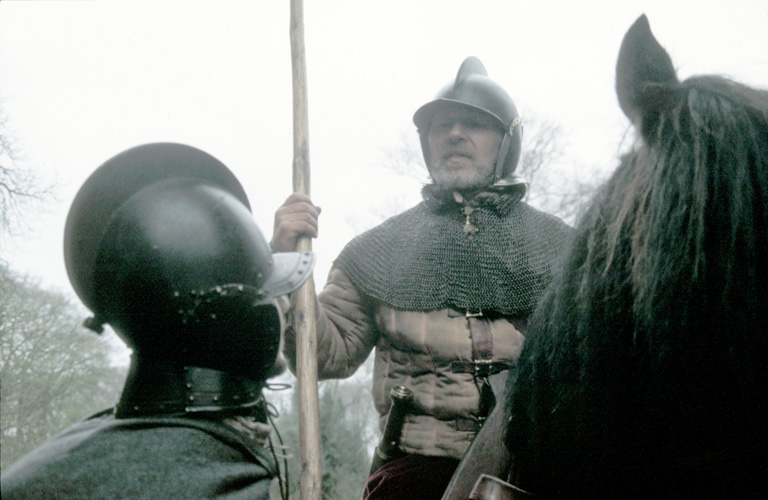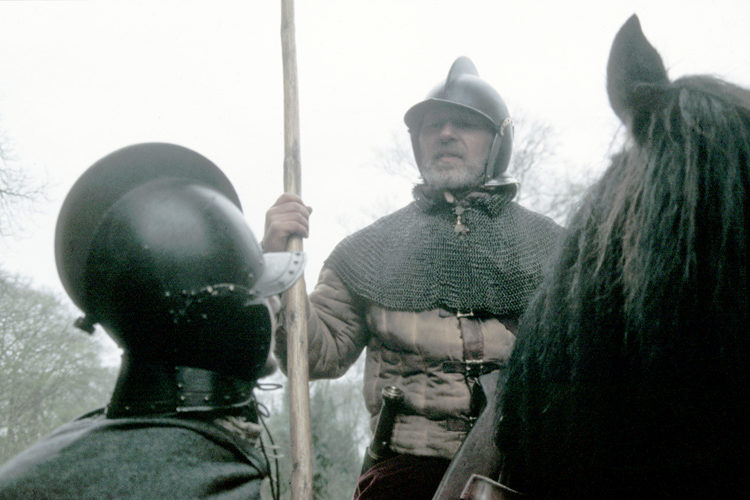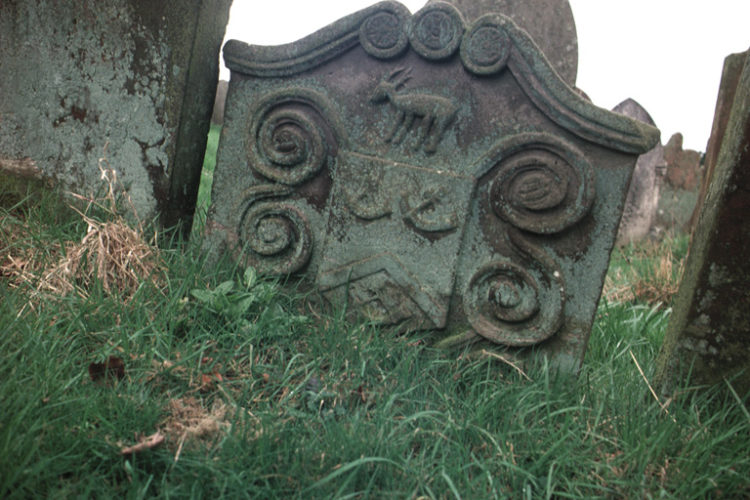The 'Peaceful Persuasion' And Transplanting Of The Marchmen By James VI Scotland & I England/Scotland…
Reiver Men Clothing
Clothing of a Reiver Farmer
A Reiver explains the various items of clothing worn in the 16th century
The actor is representing an English gentleman farmer in the north of England, Northumbria, in the late 16th century. This actor is taking the name of Herron. Herron is a well known border name. They were from time to time Wardens of the Middle March and also notorious Reivers when not performing official duties. The Reiver is wearing an outfit that might have been worn when reiving cattle from his Scottish neighbours. For body protection the Reiver is wearing a jack or brigandene, a leather protective jacket.
Underneath that, the Reiver has on a linen shirt, which has wooden buttons and is handmade locally.
The Reiver has a stout leather belt which supports a leather pouch. In his pouch the Reiver would keep basic food stuffs, a few coins and things of that nature. If the Reiver had a firearm he would also keep his shot in his pouch.
The Reiver has on a pair of hose which are close-fitting woollen breeches with a codpiece held in place by leather thongs; buttons were expensive and difficult to replace.
On his legs and feet the Reiver is wearing horseman’s boots. These are stout leather boots which extend half way up the thigh. These enabled him to ride all night without the stirrup leathers chaffing on his legs and also protected the legs against thorn bushes.
The boots also would provide a certain level of protection against sword cuts. The leather of the boots, like the leather of the jack, would provide some protection from a slash of an enemy sword or axe.
Filename: 04 0 complete outfit PN Record ID V1006
Copyright Peter Nicholson
Image filename: Painting Border Reivers KD;
Copyright of images: Keith Durham / Angus McBride Record ID: T5005
Border Reiver Foot Soldier
A Reiver foot soldier introduces himself
The Border Reivers did not always travel by horse and this re-enactor is dressed in the clothing and equipment of a foot-soldier. They were known as Footlouns. There is no uniform and weapons and clothing would vary according to that which could be made, stolen or taken from a victim.
There are two records on this database of inventories which list the variety of clothing that was used in this period. The ordinary foot soldier was the poor farm worker and would fight or raid in the same clothing that he worked in.
There was no armour for the foot-soldier and even the protective leather jack would be too expensive for him to own. If he was lucky he would steal something from the battlefield or from a reive which would protect him until it was stolen from him.
Filename: 08 Foot Soldier PN Record ID V1056 Copyright Peter Nicholson
Reiver Wearing Shot Pouch
Reiver showing his belt and leather pouch
The Border Reiver did not have pockets in his clothing and would tend to carry items in a purse called a shot pouch which was suspended from a belt around his waist. In the shot pouch he might carry a few coins or if he carried a firearm he would carry the powder and shot in it.
The pouch would be made of leather and since it was carried around his waist, it could be tucked inside the breeches to keep the powder dry and warm. When he needed to fill the gun he could quickly take it from under his breeches, load the weapon then tuck the pouch back
inside his breeches where it was protected from the weather.
The Reiver would carry other items tied to his body or horse in leather pouches. See the record showing models of Reiver on foot and horse which shows a typical Reiver returning from a raid.
Filename: 04 6 pouch PN Record ID V1011 Copyright Peter Nicholson
Reiver Wearing Hose and Codpiece
Reiver showing his hose and codpiece
The actor has on a pair of hose, which would nowadays be called trousers. Hose are close fitting woollen breeches, which has a codpiece, a separate flap of material, held in place by leather thongs.
Although the item has a fashion element, it was a practical arrangement of his clothing. Buttons were expensive to make and highly impractical to re-sew in the field. The construction of trousers with button flies has great complexity where the seams of the legs and the crutch meet.
A simple flap around the crutch allows for a simple construction and a simple method of relieving oneself. Although these breeches have a thick leather belt, many would be joined by laces to the upper undergarment which meant that no belt was necessary and also meant there was no chance of shirt and trouser separating which would cause heat loss.
Filename: 04 7 trousers_cod piece PNRecord ID V1012
Copyright Peter Nicholson
Reiver Explaining Buttons on a Jack
Reiver explaining how buttons can be a hazard on a jack during a fight
The buttons on the farmer’s garment are made of wood though sometimes buttons were made of bone and occasionally of metal.
The button holes themselves are very carefully worked into the lining of the garment with a leather flap so that when the Reiver fastens his jack, the buttons are not visible.
This arrangement provides protection against the weather , so rain did not run down through the button holes. The flap also provided protection against enemy swords; an enemy sword would be more likely to glance off the face off his jack, rather than catch on the buttons and be guided through the flap to the wearer’s body.
Filename: 06 buttons PN Record ID V1015
Copyright Peter Nicholson
Reiver with Bonnet
A Reiver explains his simple leather bonnet
This Reiver is wearing a leather bonnet with a soft leather upper and a harder leather brim and a tassel for decoration. In this period it was considered very ill-mannered not to wear a hat.
There is a functional use for a hat; the wide brim would give some protection against rain and would also shield the eyes from sun that could otherwise hide an approaching danger.
Some people wore a steel skullcap under the hat which gave some protection against a blow to the head. This steel skullcap was known as a “secret” hence the phrase “Keep a secret under your hat”.
Filename: 15 fs hat PN
Copyright Peter Nicholson
Record ID V1061
Border Hiedsman
The Warden’s assistant explains his work
The border area of England and Scotland was divided into regions called Marches. Each March had a Warden whose job was to keep the peace, though sometimes the crown sought to use them to promote a mini war. Another record shows a letter from Henry VIII asking for “men to be raised to cause mischief to mine enemies.”
The Warden had an assistant to keep his records and he was called a Hiedsman. The records were often very detailed and serve as evidence today of the wrongs committed by both Scottish and English Reivers.
The records that were kept were presented on days of truce at Wardens’ meeting places. On these occasions the Scottish Warden would present a list of grievances to his English counterpart and vice versa.
Filename: 21 Border Hiedsman PN Record ID V1065
Copyright Peter Nicholson
Border Hiedsman’s Trews and Codpiece
The Warden’s assistant describes his trews and his codpiece
The Hiedsman was wealthy and this one shows his dedication to fashion in his clothing. He wears silk pants with a woollen outer part. He completes his attire with a codpiece with which he hopes to impress the ladies.
The value of the breeches can be illustrated by the inventory of Ewanrigg Hall in Cumberland in 1585 which lists a paire of velvet briches (breeches) £2 0s 0d; a paire of silke grograin briches 13s 4d. The same inventory values his best horse at £4 and his nags (old horses) at just over £1.
The codpiece was a fashion item that was commonly displayed at that time. Henry VIII had a codpiece included in one of his suits of armour.
Filename: 23 trews PN Record ID V1067 Copyright Peter Nicholson
Border Hiedsman’s Leather Jack
The Warden’s assistant describes his leather jacket
The Reiver is wearing what is called a padded reinforced jacket called a jack. The protective jacket was worn as an alternative to plate armour or to chain mail. It has the great advantage of being light and flexible and still affords the wear a fair degree of protection against a sword thrust or lance thrust but much less protection from an arrow or a bullet.
Some of these garments had metal or horn plates sewn into the lining between the inner and outer face thus providing the wearer with an extra layer of protection. The space between the inner and outer layers of the jacket was filled with padding which not only absorbed blows but also kept the wearer warm.
The jack was fastened with laces or wooden or leather buttons, with very heavy duty stitching down the seams and along the lining. The jack is sleeveless to allow the arms to wield their weapons more easily.
Filename: 25 jack PN Record ID V1068
Copyright Peter Nicholson
Hiedsman’s Factor
A Hiedsman’s factor introduces himself
This man is dressed in the height of fashion from the times of the Reivers. He works as a clerk to the hiedsman who in turn is employed by the Warden of the March.
The name “heidsman” is probably the phonetic version of “head man” and the job title “foreman” also reflects the position of this person. He would not only keep the written records but would have the responsibilities of the estate manager or factor.
It is unlikely that this person would be involved in the fighting and high risk raiding associated with Reivers.
Filename: 38 b_Hiedsman clerk PN Record ID V1080
Copyright Peter Nicholson
Shoes With No Left Or Right
A hiedsman’s clerk shows his stockings and shoes
He wears woollen stockings and leather shoes. There is no right or left shoe so that if one needs to be replaced then only one replacement would have to be made.
Ordinary functional clothing seems to be cheap compared with the fashionable upper garments.
The inventory of Ewanrigg Hall values cloaks, jackets and trews in pounds yet the common items are valued at: two paire of yersay (jersey) stockings 3s 4d; a pettycott of flannan (flannel?) 1s 8d; two paire of boote (?) stockings 1s 4d; a paire of boottes (boots) price 3s 4d.
Filename: 44 clerk shoes PN Record ID V1084
Copyright Peter Nicholson
Hill Farmer and Reivers
A hill farmer tells about the thieving Reivers
The hill farmer was a regular victim of the thieves of the area and his only safety was to join in with the protection of the family clan. This meant that he would sometimes go on a reprisal raid or initiate his own raid if his larder was running low. It is easy to see how an ordinary farmer can become the victim and the culprit of the art of Reiving.
When a member of his clan was killed, a blood feud would exist with the transgressor’s family. Innocent members of that family could then be attacked in retaliation for the original killing. However, this started a new cycle of revenge and feud.
A record in this database from the Commission for the Pacification of The Borders shows a list of the feuding families of the Reivers.
Filename: 46 hill farmer story PN Record ID V1085 Copyright Peter Nicholson
Identification Armband
A Reiver shows how an identifying armband can be reversed
The Reiver is wearing an armband which signifies the country he is fighting for. However this Reiver has a reversible armband with the flags of both countries available.
There was no uniform for the fighting men of the borders. There was also little loyalty to sovereigns when members of the same clan lived on both sides of the border, such as the Armstrongs. Some families were notorious in being unreliable and the Grahams of the Debateable Land were hated equally on both sides of the border.
There is a story that during the Battle of Sollom Moss, Solway Moss, some border Reivers were fighting for the invading Scottish army until they saw that the battle was going against the Scots. They then promptly changed sides and captured the captains of their own army and took them for ransom. They were going to prosper no matter which side won. There were also reports that when the process of the Pacification of the Borders sent Grahams to the Low Countries to fight for the King, they were sent back because they would fight for any side that seemed to be winning.
Filename: 35 armband_flag_b PN36 armband_ransom PN
Copyright Peter Nicholson Record ID V1077 Record ID V1079
Drinking Habits of Reivers
A Hiedsman’s clerk explains the reason for the tankard at his waist
The clerk to the hiedsman of the Warden of the Marches has a leather drinking tankard hanging from his belt. The water in public places was unfit to drink and streams were often polluted by animals and people.
The safest drink was brewed either as a type of beer or wine. The beer was not made from hops as they had not been discovered and utilised at that time. Some brews of beer were based on heather and some on malted grain. Wine was likely to be from hedgerow fruit.
There is a report that on one of Edward I punishment forays into the east side of Scotland, his army ran out of beer and had to return to Berwick because they would not travel without beer.
Filename: 42 clerk drinking habits PN Record ID V1083
Copyright Peter Nicholson

